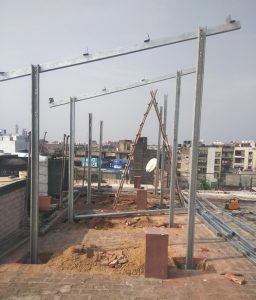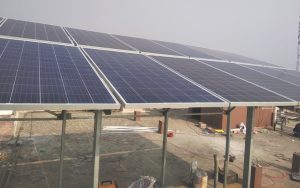Delhi holds the undesirable record of being the most polluted capital city in the world. The air quality in Delhi falls in the ‘severe’ category most of the year round and the delhites get some respite only during rains. Most of the pollution in Delhi is due to burning of fossil fuels by vehicles, generators, industries and Power plants in the periphery. Almost all the power supplied to the state of Delhi is produced by burning of fossil fuels (coal and natural gas). In the summer of 2017, the power requirement in Delhi shot up to a staggering 6526 MW every day. In 2019, the figure has already hit a new high of 6934 MW on June 8. Delhi crossed the 2017 record four times since June 1 2019.

Solar Panel Structure being installed
In addition to the rising air pollution in Delhi, another major issue is ‘Climate Change’. Changing weather patterns all around the globe is a scary phenomenon and increasing temperature due to greenhouse effect is a reality which needs to be tackled urgently. As per reports, if the world temperature rises by two degrees, mountain glaciers and rivers will start to disappear and mountainous regions will see more landslides. According to scientists, extreme weather events will only increase if global temperatures are not limited within 1.5 degrees Celsius. Warming at present is already well over one degree. At current trends, the world could see temperatures rise to well above two degrees by 2065 (Read More).
Environics Trust has been working on climate mitigating measures for several years and have been at the forefront of fight against several projects which would have been detrimental to the environment. Fight against deforestation and fossil fuels have been an important aspect in all the work undertaken. Environics has also been an advocate for Renewable energy and communities have been encouraged to do their bit.

Solar panels ready for installation
In order to put into practice our stated position on using more renewables, Environics has installed a 5KW roof top solar power plant. The plant has been successfully installed and activated in March 2019 and Environics has been reaping benefits of not only reducing our usage of fossil fuels generated power but also reaping a reward by selling excess power to the discom.
The installation experience – The plant has been installed by Oakridge Energy Private Ltd. The installation of the plant took 3 days as it is an elevated structure with the top end measuring almost 13 feet. This has been done keeping in the mind the continued un-hindered usage of the roof. 16 solar panels have been installed for a total generation of 5KW. Although the installation itself was quite smooth, the main issue and hurdles were raised by the discom to clear the application for Net Metering (process by which excess power generated is sold off to the discom). Finally, the plant started generation in the afternoon of March 6, 2019.

Structure, MCB and Inverter

Installed Roof Top Solar Plant
The Economic Benefits – An important benefit is the return on investment (considering the cost incurred on the installation as an investment instead of as cost). Consider the table below which shows the units’ generation data so far
| Month | Units Generated | Savings @ INR 8 |
| March* | 569 | 4552 |
| April | 720 | 5760 |
| May | 753 | 6024 |
| June** | 431 | 3448 |
| Total | 2473 | 19784 |
* Plant started functioning on 6 March. Data available for 24 days
** till June 20, 2019
The generation depends on several factors like the irradiance available, cloudy weather, rains and dust. Due to a safety feature the plant stops producing power during a discom power cut.
In the time since the plant has been operational, on an average 23.33 of power is generated per day. Considering that the unit rate which BSES charges (Commercial Connection unit cost ) is INR 8/-, we are generating an equivalent of INR 186.60 worth of power every day
| Avg Units generated per day | Unit Price (INR) | Cost of Power Generated (INR)/Day | Cost of Power Generated per Month (INR) | Cost of Power Generated per Year (INR) | Cost recovery in years |
| 23.33 | 8 | 186.60 | 5600 | 68124.15 | 4.25 |
The table above shows that the solar roof top plant pays for itself in about 4.25 years while its life will be about 25 years. The monetary saving in itself will be almost INR 1.2 million (4.3 times the initial investment). In case the units generated are more, the benefits will be higher.
Other important benefits –
- The most important benefit is reducing our carbon footprint. Our office completely runs on Solar power during the day (normal functioning without use of AC).
- The plant also saves almost 3 tons of CO2 emissions per year. The calculation is based on the fact that Delhi witnesses on an average 250-275 days of sunlight in a year and assumes that reduction of CO2 emission per 1 kWh of solar power = 1 kg of CO2[Read More].
- The Solar plant further helps in offsetting the “Urban Heat Island” affect by not allowing the roof underneath to be heated up. Although this may be miniscule if considered independently and in isolation, but there may be substantial changes if more roof area gets covered and more plants get installed. The heat affect will also be felt on floors below.
- The space below the plant can be utilised for urban agriculture. Water tanks can be placed below the panels to shield them from direct sunlight and avoid heating of water in summers (energy saved to spend more energy to get it cold)
The numbers speak for themselves. The returns are not only monetary but the action is completely environmentally sound. Urban agriculture, Cooling benefits, reducing carbon footprint are just some of the direct benefits from the Solar Roof top plant. The evidence for more such installations is clear and logical.
A small initiative which is leading towards reduced Carbon Footprint for Environics Trust
Author – Mohit Gupta

Recent Comments